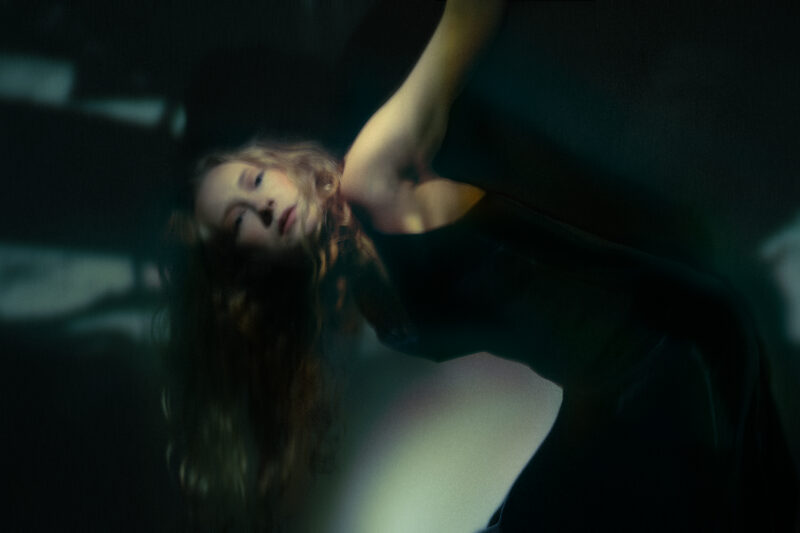Last night, I took a walk along Budapest’s riverside, the reflection of my large yellowish-white company in the calm waters of the Danube. Rippled by tiny waves, the water caressed the moon. The moment had an eerie lightness, a lack of gravity to it. Yet the mystery of the night sky and deep waters stirs bittersweet melancholy – the weight of some distant unknown. The Swedish musician and stop-motion artist Vargkvint makes music that encompasses these ambiguities between light and dark, heavy weight and airy lightness, moon and the sea. The album title Månens hav translates to ‘Oceans of the Moon’ and is inspired by the belief former astronomers had of dark parts on the moon’s surface being oceans. It is a highly conceptual piece that centers the mysteries and beauties of the moon and the ocean and calls out human-made climate change. Following the release of the record, we spoke to Vargkvint, otherwise known as Sofia Nystrand.
“The name Vargkvint is an odd word even in Swedish,” Sofia says, explaining the story of her stage name. “I found the term in an old book of music theory. Today it’s standard that we tune instruments in a way that makes it possible to play music in all keys but historically there have been a lot of different tuning systems. One of the guys that meddled in this was Pythagoras. According to his system, you get a perfect tuning except for in one place on the instrument where you get ‘a fifth that sounds as bad as when a wolf is howling’ – or what in Swedish would be a ‘Vargkvint’.”
“For me [Vargkvint] represents that there is beauty in imperfection. It has helped me a lot when writing music and struggling with my own imperfections.”
A Journey to Månens hav
As bad as a howling wolf is certainly not what Vargkvint sounds like. Who even says that a wolf howling sounds bad and not rather raw and beautiful? Drawn towards the moon in nocturnal landscapes, maybe the howling wolf and the artist have something in common. The singer describes the theme of the record as being “inspired by the oceans of the moon” while also telling “stories about what we as humans project onto the moon”.
The explorations of the ‘Oceans of the Moon’ begin with three tranquil ambient songs, a “poetic longing towards the moon”. The following songs are dedicated to the Greek goddesses Artemis, Selene and Hecate. They are “reflecting on the connection between the moon and femininity, the cyclical connection to menstrual cycles and the godlike entity that is the moon.” Then, the album returns to the moon but its seas are rougher now. Stillhetens hav II and Gränslandets hav are synth-heavy and raw. Like this, Vargkvint captures the tension of the race to space and the moon landing sonically. The last song Molnens hav provides a calming ending to the “sometimes scary story about the moon and about us strange humans.”
Salty Notes and Stormy Oceans

Photo by Fabian Rosenberg
“I think the relationship between humans, technologies and nature is probably my biggest inspiration and where a lot of my creativity comes from,” Vargkvint says. Growing up in a small oceanside town in Sweden, the artist established a connection to the sea from a young age. Observing the Swedish archipelago sparked her interest in the seas and its creatures. “Humans will probably be fascinated by [the moon and the ocean] and find a source of creativity in them as long as we exist. Maybe because of the frightening beauty they possess or maybe because we don’t really understand them yet.”
“I think there will always be a bit of the ocean in my songs. For me, the stormy, or maybe just the gloomy, rainy, and foggy ocean has always been the most inspiring. I loved it when me and my dad would go out with the boat and the weather turned and I could watch the clouds thicken. Sometimes, the waves were so high that you couldn’t see over them and at that point, you really understand how small and insignificant you are to nature.”
During a period of intense research about the moon, astrology, and the ocean, Vargkvint got interested in following the tides and the different moon phases. The cyclical nature of the tides influenced by the moon, as well as the menstrual cycle, are both recurring themes on the album. The artist explains that the recordings of the album were even made during the full moon giving it a special connection to the moon phases. Through the stop-motion music videos, she gives the stories of the songs a visual format.
Artemis, Selene and Hecate
Another vessel for Vargkvint’s inspiration is the millennial old Greek mythology and the connection to the phases of the moon that she traces. “I am more brought up on the Swedish folklore of otherworldly creatures. In older Greek religions, the three goddesses were connected to the moon in different ways. That power really inspired me. In circles of New Age Selene, Artemis and Hecate can also be connected to the roles that women take on during a lifetime, which I found interesting.”
The songs represent the journey of a woman in connection to the moon. Seeing Selene as the new moon, and a younger woman, Vargkvint describes the composition of the song as a serene longing or wandering. This is followed by Artemis, the goddess of hunting and childbirth. The song represents “the full moon and the powerful and mystical energy that can be connected to it”. In Hecate, the singer sees an older and wiser woman but “also a darker energy coming from the hidden moon”. Vargkvint goes through the different phases of the moon and connects them to her interpretation of Greek mythology. While listening, you can sonically immerse yourself in the musical result of research and the creative connotations. But the record takes a different shape when put into this conceptual context.
Reaching Into Oneself
There is something gained, but also something lost when you know what the artist was occupied with during the writing process of this full moon record. I hope you listened to some of the songs before you joined our conceptual conversation. I hope you got as lost as me in the waves of Vargkvint’s ambient compositions and met all their gloomy, abstract, and otherworldly characters. Part of the beauty of ambient music is the freedom of mind it allows the listener to have. Wrapping you into a blanket of sound, the melodies, harmonies, and compositions can be fertile ground for sifting through your thoughts or the welcome labyrinth to hide from them.
Vargkvint describes this effect as “reaching into” oneself. While her creative process is largely shaped by her work with concepts and themes, the ambiance of her musical output helps her explore more abstract ideas. It is not necessary to know all the influences and sources that make the album. “If I can provide a place where my listeners can dive into themselves and discover something about themselves through my music, I am very happy”, Vargkvint says.

Photo by Fabian Rosenberg
A Record of Secret Meanings
Månens hav starts as an instrumental album. You may not expect a vocal appearance. Yet, Vargkvint who considers herself more of a singer than a pianist, sings on Gränslandets hav and Stromarnas ocean. The soft timbers of the Swedish lyrics blend seamlessly into the composition. To those who do not speak the language, the laments for technology floating in space and the people who died in the race to space, are lost. However, in that space of not understanding, akin to the character of ambient music, lies an intriguing mystery: “Sometimes there can be a big relaxation in not knowing what is sung, then you can make up your own lyrics or secret meanings”.
A record of secret meanings describes the debut by Vargkvint well. In its quiet intensity, the album sounds like it resonated and grew in the deep chambers of the artist’s heart. A musician who writes and composes first and foremostly for herself, a longing for a creative expression of the aches, joys, and mysteries of the human condition.
Moonshine Music
While the ambient character gives the record an airy quality for the listeners to breathe, its conceptual background poses big questions. One important conversation Vargkvint hopes to continue is the one around climate change. “Sometimes we seem to forget that we are in fact part of nature, not set apart from it. At the same time, I think I was writing this music almost as an escapist way for myself to cope and hide from the anxiety I’m feeling regarding climate change. I wanted to look away from this world and dream away to something else. Maybe that is what I’m trying to offer my listeners as well, a space to explore and to escape into and get lost – and to contrast the earth’s chaos”.
After our conversation, I want to take Månens hav to the stormy ocean, to foggy seaside nights, and listen to it when the full moon is out. I want to see whether its sound changes, whether different pieces fall into place, and whether the sonic journey leads me elsewhere in the proximity of the environment and forces of nature that birthed the record. Back in Berlin and in the heat of budding summer, most of those scenarios are as far away as the Swedish coastline. But still, on a solitary walk through the barely awake park or in the nocturnal gust of wind on the 6th-story balcony, I hope to set foot into the world of Vargkvint.
Månens Hav is out now via LEITER.
Every Monday, the NBHAP staff brings an exciting new artist to your attention alongside a 30-track-strong Introducing Playlist on Spotify. Feel invited to follow the playlist and give these talents a spin. Sign up for our Newsletter to receive monthly updates about new music.
This week, we curated the playlist together with Vargkvint. Along with tracks from her new album, this week’s update includes Marta Cascales Alimbau, Holland Andrews, Hania Rani and more. Tune in below.



